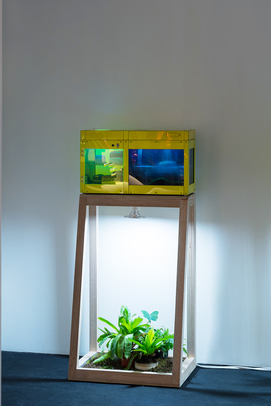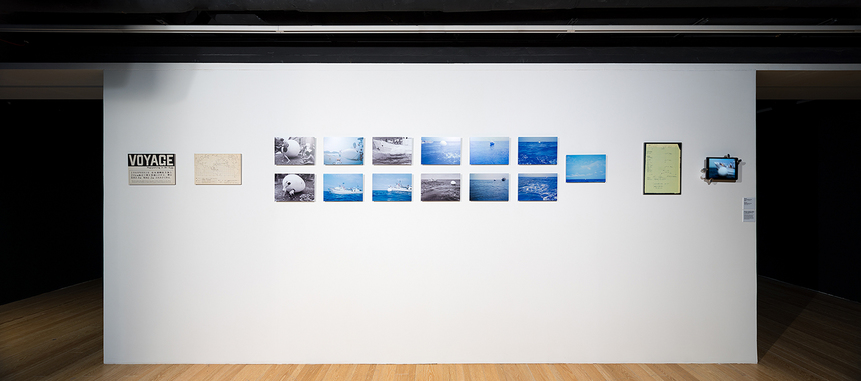-
From Current Issue
-
- Editor’s Letter Fire in the Heart
- Reviews I Gusti Ayu Kadek Murniasih
- Reviews 11th Seoul Mediacity Biennale: “One Escape at a Time”
- Dispatch Networked China
- One on One Monira Al Qadiri on Yukio Mishima
- Essays The rise of independent art spaces in pandemic-era Shanghai
- Features Tuan Andrew Nguyen
- Table of Contents
- Web Exclusives
- Archive
- Subscribe

R
E
V N
E
X
T
Installation view of “Emerald City” at K11 Art Foundation’s Pop-up Space, Cosco Tower, Hong Kong, 2018. Courtesy K11 Art Foundation, Hong Kong/Shanghai/Wuhan.
Probing a set of unconventional lenses through which to re-examine the state of the world, “Emerald City,” presented by K11 Art Foundation, brought together 39 artworks—spanning multiple media by artists from over nine countries—under the theme of geometry. Rather than take on the normal understanding of geometry as the mathematical study of shapes and spaces, the show dissected the discipline, utilizing it as a means to refract and explore the intricate relationships between people, and how they position themselves to make sense of their environs.
While at first this overlapping of the concept of geometry and the scrutinization of the world’s broader systems appeared metaphorical and unnecessary, it did encourage viewers to review pertinent issues, including environmental sustainability—a particularly strong thread that ran throughout the exhibition—from different angles and spaces. Carl F. Cheng’s Erosion Machine No. 2 (1969), displayed at the K11 pop-up space—one of the show’s two locations—is meant to be a microcosmic view of natural forces. In particular, it allows viewers to witness the process of rocks being eroded. Cheng attached florescent-yellow acrylic tanks containing two compartments to wooden stands. In one of the sections, lumps of cement and plaster are painted in glaring colors. On the other side, under blue light, jets of water chip away at a chunk of aggregate, slowly eroding it. Already tuned in to the environmental movement in 1969, his “nature machine” is designed to “model nature, its processes and effects for a future environment that may be completely made by humans,” according to the artist’s statement.
The Play, a Japanese artist group, also touches on the theme of environmentalism through their work Voyage: Happening in an Egg (1968). The performance entails the collective releasing a 150-kilogram egg, measuring over three meters long and two meters wide, into the Kuroshio current, which sweeps across the eastern coast of the Japanese archipelago. The process was documented in videos and sketches, which were on view at chi art space, the show’s second venue. A month after the object’s release in 1968, the group received a telegram from a sailing ship informing them that they had spotted the floating plastic-resin mass. Since then, however, it has disappeared again. The performance demonstrates the powerlessness of human beings in comparison to nature, which is capable of swallowing our creations and wiping out our existence.
Continuing with the theme of the sea, Bali-based Ashley Bickerton’s Seascape: Floating Ocean Chunk No. 1 (2017) references the act of sending out a message in a bottle. However, unlike the work by The Play, Bickerton’s sculpture seems to suggest that nature is the one deploying signals for help. Sandwiched between two metal tubes, capped on both ends with fluorescent orange paint, is a spotted turquoise plane, which resembles a section of the sea—it is as if the patch of water has been attached to a flotation and self-preservation device. On the other hand, the cylinders are both emblazoned with the word “Susie” in the center. “Susie” is a brand name Bickerton invented, and by slapping it onto his work, he reduces his own agency to that of a corporate body, commenting on the commodification of art, and the enduring fetishism that surrounds objects, which continues to plague our world and fill our oceans with extraneities.
Alice Wang, a young Chinese artist based in Los Angeles, is also inspired by the sea, or what came out of it. In Wang’s work, Untitled (2016), a group of 300-million-year-old crinoid fossils are gilded in 24-carat gold. The artist intended to create a new substance with the fossils, which are marine animals considered to be the oldest living species on earth, and gold, which forms naturally. However, the effect is underwhelming—the combination of the two naturally occurring resources did little to transform understandings of either.
While at moments the exhibition was too expansive to offer congruent arguments or perspectives, “Emerald City” accomplished what it promised by presenting a myriad of engaging artworks that speak of humanity’s relationship with earth and the value systems that we have constructed for ourselves.
Kayo Chang Black is an editorial intern of ArtAsiaPacific.
“Emerald City” was on view at K11 Art Foundation’s pop-up space in Cosco Tower, Hong Kong, from March 28 to April 22, and is at chi art space, Hong Kong, until May 31.
To read more of ArtAsiaPacific’s articles, visit our Digital Library.







